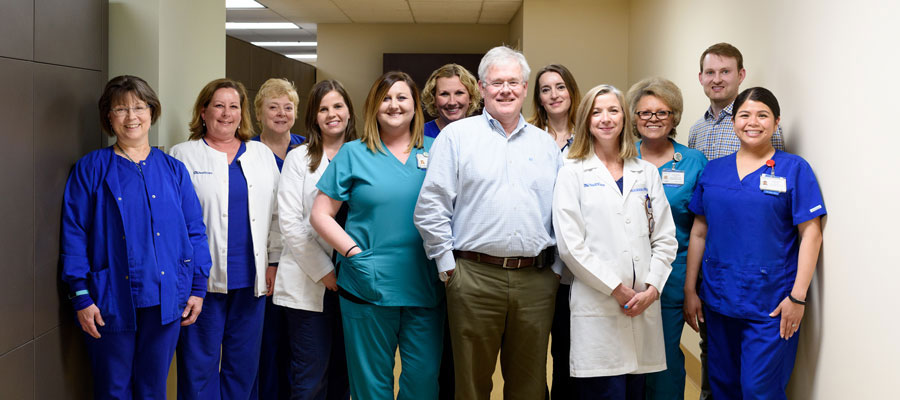UK anesthesiologist suffered a heart attack while at work, but found vital care nearby
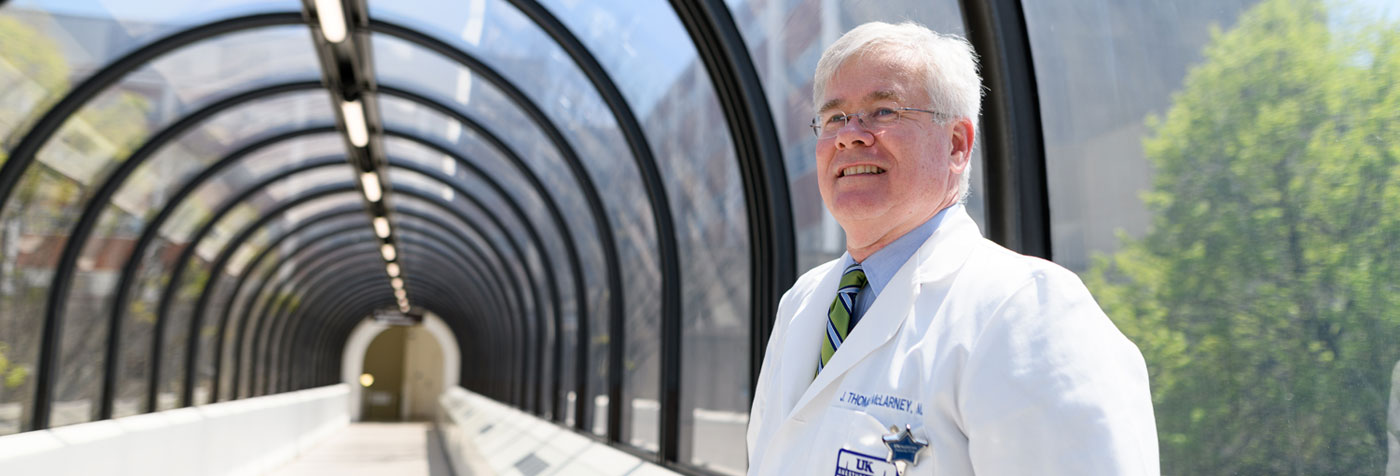
It felt like a “pop.”
Not pain. Not tightness. No, it was a distinct pop in his chest that made Tom McLarney, MD, pause in the middle of his rounds in the Anesthesia Preoperative/Preprocedural Assessment Clinic at UK Albert B. Chandler Hospital.
The events that unfolded in the minutes and hours that followed the “pop” rallied the UK HealthCare family of skilled caregivers together around one of their own. Their expert teamwork demonstrates how high-quality, advanced medical care, administered quickly, can mean the difference between life or death during a heart attack.
“There’s no way”
August 19, 2016, started like any other work day for McLarney. He woke up and showered. He kissed his wife, Tracey, said goodbye and that he would call her later. He drove to work at Chandler Hospital, where he has spent his entire 28-year medical career.
“I can’t imagine working anywhere else,” he said. “I am so proud of UK as an institution and of the people who take care of our patients.”
He faced a typical workload that Friday. As medical director of the clinic, he meets with patients preparing for surgery and consults with the doctors who order and perform those procedures.
“One part I really enjoy about my job is that I get to interact with physicians from a lot of different medical specialties,” he said.
Sometime around midday, as he was talking with the clinic’s three nurse practitioners, it happened: the pop. “It didn’t really hurt,” he said. “I was aware of it. I remember thinking, ‘There’s no way I am having a heart attack.’” After all, at age 53, he was an active guy, a lifelong runner who had run a marathon on his elliptical machine within the past year. He had repeatedly shoveled that previous winter’s heavy snow for hours at a time without problems.
Still, McLarney made a deal with himself: If that sensation was still there in 30 minutes, he would get an electrocardiogram (EKG), a test that records the electrical activity of the heart. Only 15 minutes later, his jaw started to hurt – a major red flag. “That’s when I knew: This is a heart attack,” he said.
“Maybe a little one”
Cardiology technician Kimberly Sturgeon was on duty in the clinic’s EKG room when McLarney came in to request an EKG. “I’m not used to the anesthesiologist I work for being the one in need,” Sturgeon said. “As I hooked up the electrodes to run his EKG, he tried to play it off like it was no big deal, that he just wanted to check out why he was feeling the way he was.”
Sturgeon had watched McLarney at work with his patients during her three years in the clinic.
“He is the epitome of what you want your doctor to be,” Sturgeon said. “He is always concerned about how the other person is feeling. That’s who he is, and I think that’s the reason he downplayed how he was feeling that day.”
McLarney nonchalantly took his EKG, walked down the hall and called UK•MDs, the medical contact center that connects physicians to expertise within UK HealthCare.
“I am on the phone with them so much all day, every day,” he said. “They know me so well that they recognize my number and answer with, ‘Hello, Dr. McLarney.’”
“I immediately knew this was an acute heart attack. I knew we had to initiate the ‘go’ response right away. I asked him, ‘Whose EKG is this?’ He responded, ‘John, it’s mine.’”—John Gurley, MD
This time, he asked UK•MDs to connect him with John Gurley, MD, a cardiologist and director of UK’s Structural Heart Program. McLarney has known Gurley for more than 20 years and frequently consults with him on cases.
“I have always thought the world of John,” McLarney said. Gurley called him back less than a minute later. “I have an EKG I need you to look at right now,” McLarney told him. “Where are you? I am coming your way.”
McLarney was halfway across the bridge between buildings, on his way to the Cardiac Catheterization Lab (known as the cath lab) in the Gill Heart and Vascular Institute, when he stopped in his tracks.
“I realized I hadn’t said anything to anybody back in my department,” he remembered.
He backtracked to the anesthesia preop clinic to let his staff know where he was heading. As McLarney set off again across the bridge to the cath lab a quarter-mile away, the gravity of his situation truly sank in.
“I was thinking, ‘How ironic if I went down with a heart attack, right now on the bridge, with my own EKG in my hand,” he recalled. He knew it was time to call Tracey. “I’m trying to think of a way to tell my wife I am having a heart attack without making her panic and rush over to UK and have a car wreck on the way,” he said. “So I start off the conversation with, ‘Everything is fine’ – which I realize, as I am saying it, is the worst way to start. So I tell her, ‘I’m OK, but not feeling well, so I am on my way over to the cath lab.’ She said, ‘Wait, wait – are you having a heart attack?’ I told her, ‘Well, maybe a little one, but I’m fine.’”
He stopped to share that same message with his boss, Edwin Bowe, MD, then-chair of anesthesiology.
“He told me he wasn’t feeling well and that his EKG had some abnormalities,” Bowe said. “He looked really rough. He looked gray.”
The ‘go’ response
Dr. Gurley had no reason to be alarmed by McLarney’s request.
“Tom is an ambassador for his patients,” Gurley said. “If he’s concerned about a patient, he’ll ask me to take a look at things and tell him if he’s on the right track. So for him to call and ask me to look at an EKG, I was happy to do so. It was just a friend calling and asking for a minor favor.”
Gurley happened to be on a brief break between cases, standing in the hallway outside of the cath lab with nurse Paul Morrison, RN, when McLarney arrived and handed him the EKG.
“I immediately knew this was an acute heart attack,” Gurley said. “I knew we had to initiate the ‘go’ response right away. I asked him, ‘Whose EKG is this?’ He responded, ‘John, it’s mine.’”
Go. In that instant, McLarney transformed from friend to patient.
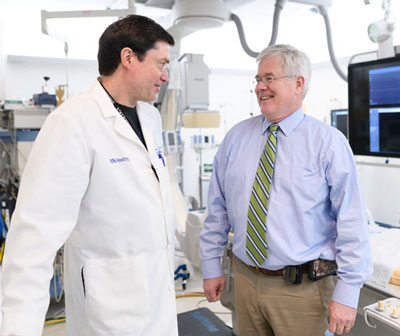
“Within a split second, you comprehend all the things that can go wrong,” Gurley said. “I was most concerned that his heart would stop there in the hallway, before we could get him in a cath room where we have our tools and can take care of things in a controlled manner.”
Gurley quickly scanned the clinic. There were no open beds in the prep area, but cath lab 3, one of the procedure rooms, coincidentally happened to be clean and open for its next patient. Regardless of what the schedule said, that next patient was now McLarney. Morrison and Gurley took McLarney by the arms and hustled him into the cath lab in seconds.
“Tom was caught up in the automatic response that takes place so fast, it was like a cyclone hit him,” Gurley said. “My team has a very rapid, efficient and well-choreographed response when a patient has an acute heart attack. We don’t need to think about it – we just do it.”
In swift succession, the team started an IV and hooked McLarney up to a monitor. They injected a radioactive dye into his circulatory system that would mark the blocked artery responsible for the heart attack. They set up an advanced X-ray machine that takes a rapid series of images, called angiograms, to visualize the blocked artery. “It was amazing to watch the team go from zero to 100 miles per hour,” McLarney said.
At that moment, McLarney felt “a peace that surpasses all understanding” – a Bible verse he had long known but had not experienced before. “I didn’t want to die, because of Tracey and our two children and the work I had left to do here. But for the first time in my life, I felt I was ok to go, because of that peace,” McLarney said. “I looked up at John and told him, ‘If I don’t make it, tell Tracey I love her.’ John looked down at me with that smile of his and said, ‘You will be fine. You tell her yourself.’”
Around 90 seconds later, McLarney’s heart stopped.
In expert hands
When a patient goes into ventricular fibrillation, the lower chambers of the heart quiver erratically and the heart stops pumping blood. There is no circulation, so blood flow to the brain stops. It can cause permanent brain damage within a matter of minutes – and kill just as quickly. McLarney’s heart fibrillated twice within a matter of minutes.
“If this happens in a public place, it doesn’t work out well,” Gurley said. “But in our procedure room, that same scenario looks very different. An observer might not even be able to tell there’s anything wrong. The person monitoring the hemodynamic monitor will say, in a calm voice, ‘VF.’ I might respond, ‘I am aware of that,’ and ask someone to charge the defibrillator. I then use the defibrillator to shock the heart back into a regular rhythm. Then we’d continue with our work.”
After stabilizing McLarney, the team continued with the procedure. The angiogram revealed that McLarney had a complete blockage of one of his major coronary arteries.
“That happens when a small area of cholesterol plaque becomes unstable and leads to the formation of a blood clot forming in an artery,” Gurley explained. “That cholesterol deposit causes a narrowing of the artery, then completely obstructs it. That obstruction is what leads to the heart attack.”
Now that he knew where the blockage was, Gurley needed to clear it. Through McLarney’s wrist, he pushed a needle into the distal radial artery and inserted a plastic tube up through the artery to the blockage. Using the tube as a channel, he passed a small guidewire up into the blockage and expanded the wire with a balloon. He then inserted a stent, a mesh wire tube, to keep that section of the artery open.
“This kind of procedure can take just a few minutes or several hours, depending on how complex it is,” Gurley said. “Tom’s procedure went very fast. We reopened his artery quickly enough to prevent any damage to the heart. Usually, we consider 90 minutes to be the critical window for a patient with a heart attack, from when that person first contacts medical services to when we open the artery. For Tom, though, you don’t get any luckier. The fact I was right there, that a room was open, that staff was available is amazing. The goal is 90 minutes, not 90 seconds.”
Circle of support
“I am so happy to be here.”
That was the first thought that entered McLarney’s mind as he regained consciousness in the cath lab recovery room. When he opened his eyes, he was surrounded by company. Tracey was at his side, along with their son, Brannon, 22, and daughter, Keegan, 17. Two of his pre-op clinic nurses – Hillary Glenn and Lora Morrison, RN, Paul’s wife – were there, too.
“When we heard he was in surgery, we were all worried,” Lora Morrison said. “Paul and I have known Dr. McLarney since he was a medical resident. But those of us on his staff knew that he was in good hands; our cath lab is tremendous.
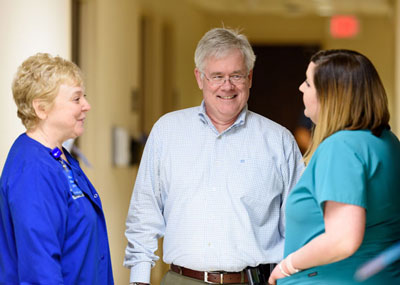
When Paul told us he was in recovery, we rushed over to check on him – and give him some grief. We were mad at him for not saying anything to us, for not asking someone to get him a wheelchair rather than walking himself over to the cath lab.”
Indeed, word of McLarney’s solo march across the bridge, EKG in hand, had already spread far and wide across campus. “We usually try to restrict visitors to one at a time,” said Kelly Kampmann, RN, the recovery room nurse responsible for McLarney’s care. “But there were around 30 people lined up to see Dr. McLarney – physicians, VIPs. I joked with Dr. McLarney that I could have made a small fortune selling tickets.”
McLarney was overwhelmed by the outpouring of concern from colleagues from every stage of his medical career at UK. “It showed the closeness of the UK family,” he said. “I was so struck by that: We are a family.”
Among his visitors – and closest UK family members – was Dr. Gurley.
“It can be very emotional for the patient and family to think about a life-threatening heart condition,” Gurley said. “I try to be a calming factor. I tell the patient, ‘You had a problem, but we fixed it today. You will be fine. There are things we need to do to make sure it doesn’t happen again, but do not worry. Everything will be ok.’”
After a few hours, McLarney was moved into the Cardiovascular Intensive Care Unit (CVICU) for an overnight stay. Monica Hardy, RN, was among the nurses who looked after him during his ICU stay.
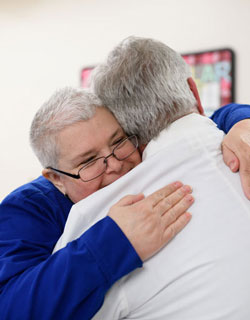
“Since he was a doctor, he understood everything about his care. He was walking around soon after he arrived and was very motivated to get well.” Hardy said. “I told him I was interested in going to nurse anesthesia school, and he was really encouraging and supportive of my hopes and dreams.”
Sleep was hard to come by that night. The EKG leads on his chest pulled uncomfortably every time he moved. “I remember thinking, ‘Wow, it’s just me and the beep of the EKG,’” he said. Yet, he was not alone. He heard a voice – a voice he believed was the Holy Spirit. “It said, ‘Tomorrow is not promised,’” McLarney recalled. “I exploded into tears and laughter simultaneously. I felt such raw emotion – joy and thanksgiving and relief for the whole thing. I raised my hands in the air and said, ‘Message received. Thank you.’”
Rapid recovery
McLarney’s ICU stay was brief – less than 24 hours.
“He was a model patient,” said Adrian Messerli, MD, the cardiologist on duty in the CVICU. “He had a good understanding of why it happened and was motivated to get well and figure out what he needed to do to be better.”
Among McLarney’s final ICU visitors was Craig Beavers, PharmD, cardiovascular clinical pharmacy coordinator. He discussed McLarney’s antiplatelet medication – to prevent future clotting – as part of UK HealthCare’s KATS-PLEDGE program. “Through this program, we provide extensive education to patients about their medication, explain what is expected of them, check if they’re able to afford their medications and arrange their first follow-up appointment,” Beavers explained. “It’s a pharmacist-led program designed to reduce patient readmission.”
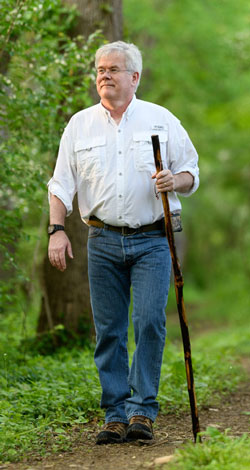
McLarney had no intention of returning to UK as a patient. However, he was already eager to return to work. After settling in at home, he talked to Dr. Bowe.
“Forty-eight hours after the intervention, he told me, ‘I am ready to come back to work on Monday,’” Bowe recalled. “Tom was trying to be a good company man. He knew we’d be short staffed and didn’t want to have others carry his weight. I told him, ‘You may think you are ready, but you are not. You need time to recover, not just physically but emotionally.’ He needed time to come to grips with what happened, to make adjustments in his lifestyle and to spend some time with his family.”
McLarney agreed reluctantly to a two-week respite. “Dr. Bowe knows me well,” he said. “He knew I needed to hear those orders from him.”
McLarney’s only forays onto the UK HealthCare campus during those two weeks were for his prescribed sessions at the cardiovascular rehabilitation clinic. Nurse Nancy Kessler, RN, was surprised to see his name on the patient roster.
“I’ve known him for 15 years,” she said. “It’s always an eye opener when your patient is someone you know, who is young and in good health. It was good to see him and to be able to help him with anything he needed in the rehab clinic.”
“The UK staff is so good at taking care of all of their patients. UK’s facilities are certainly impressive and cutting-edge. But the strength of UK is its people.”—Tom McLarney, MD
In addition to the friends and family who called on him, McLarney said he was paid another visit by the Holy Spirit. “Right out of the blue came the message, ‘What are you waiting for?’” McLarney said. “I froze for a second, confused. Then knew I what it meant: I had to share the story of my experience.”
He has. He has spoken to his church and his men’s Bible group. He uses his experience to guide him at work – where he returned, as planned, just two weeks after his heart attack.
“Patient relationships have always been important to me,” he said. “But I think I am a better listener and better physician now after being a patient. When I teach my residents about personal interaction with patients, I think my insights have more gravitas, now that they know my story.”
He hopes his story also can help others to recognize, and respond quickly to, the warning signs of a heart attack. For the American Heart Association’s annual Heart Ball in Lexington, McLarney spoke in a video about his experience. Along with Dr. Gurley, he recounted the events that unfolded and emphasized the lesson learned on that fateful August day: a heart attack can happen to anyone, anytime, anywhere.
“Thank God I was at UK when it happened,” McLarney said. “The UK staff is so good at taking care of all of their patients. UK’s facilities are certainly impressive and cutting- edge. But the strength of UK is its people.”
